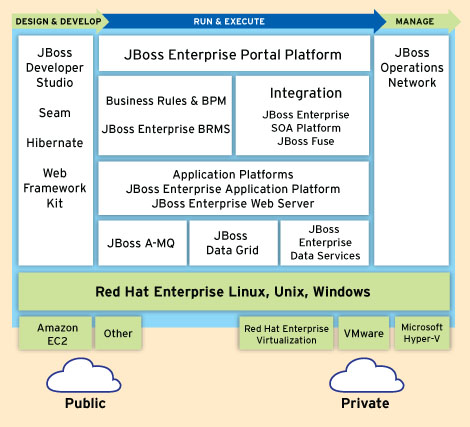Red Hat yesterday announced some key pieces that will begin to pull together the company’s JBoss line of middleware solutions into a platform for what it’s calling the “intelligent integrated enterprise.”
The company made generally available JBoss Fuse (the integration piece formerly known as Fuse ESB Enterprise before it was acquired from FuseSource in September 2012), and JBoss A-MQ, the rebranded and fully supported open-source messaging queue based on Fuse MQ Enterprise and the Apache ActiveMQ project.
To illustrate what he meant by “intelligent integrated enterprise,” Pierre Fricke, Red Hat’s director of integration and BPM products, used the example of a website that sold basketballs. When a user clicks on the basketball to purchase, he or she is offered other types of balls to purchase, such as baseballs or footballs, and the only delivery option is by direct shipping. But it’s more likely the purchasers of a basketball would want an air pump or a jersey than a football, and they might want to pick it up from a local store because they need it for a birthday party later that afternoon, he said.
To achieve this, organizations need to realize that “the enterprise extends far beyond the data center,” Fricke said. They need to tie in to their back ends for updating the application, taking the order, processing it, billing, and shipping, but they also have to connect to external systems of their partners, outlets and distributors. And, they need to know what kind of device the customer is using.
Organizations try to do this with batch delivery and a hub-like architecture, but these only enable each end point to communicate with the central server, not with each other.
The JBoss vision of intelligent integrated enterprise breaks down batch deliveries and hub-like communication by deploying ESBs and messaging queues at store outlets, with distributors, and on devices.

JBoss Fuse is the integration solution that holds the intelligent integrated enterprise together, according to Fricke. “These are very popular integration frameworks for developers, and they had community” around them in the open-source world, he noted. “Fuse provides integration everywhere, not only at the core.”
The core ESB of which he spoke is made up of other FuseSource acquisitions based on Apache projects: Camel, the patterns and development environment; CXF, the integration stack; and ActiveMQ for messaging. Fuse and the Core ESB are available now.
The company also plans to release a SOA platform later this year that will add capabilities for developing, deploying and integrating applications, along with governance and registry. “The SOA platform offers more out of the box than Fuse,” Fricke said. It uses the Service Component Architecture and is based on JBoss’ Enterprise Application Platform; Fuse and A-MQ are based on OSGi.
The solution uses the JBoss developer tools and application server for developing and deploying apps into this enterprise, and JBoss Data Grid can be used to add a distributed data cache for abstraction and integration. By adding the JBoss Data Services Platform, “you can virtualize data and format it in a way that external applications can understand,” Fricke explained. Red Hat this week updated its distributed data caching solution Data Grid to version 6.1, with new features such as replication across clusters and locations; improved map/reduce for long-running compute applications; and improved elasticity that does not block state transfer.
The intelligence layer is added on top of this integration structure through the use of JBoss Enterprise BRMS (for business rules modeling) and a business rule engine to automate transactions as users come to the site via the JBoss Enterprise Portal Platform, Fricke said. Much of the intelligence tooling being built into the JBoss solution was acquired when the company purchased the Spain-based business-process-management company Polymita in August. “It offers simulations and better analysis tools,” he said, adding that JBoss expects to turn its BPM pieces into a full BPM suite “before the end of the year.”
Down the road, Fricke said Red Hat will look to run on open hybrid clouds via an integrated Platform-as-a-Service, and to create “cartridges” to run on OpenShift. The company is also previewing a Hive connector in its Data Services platform, bringing Big Data into the equation. Lastly, the company is looking to create social data streams “to bring social streaming into the intelligent enterprise,” he said.






